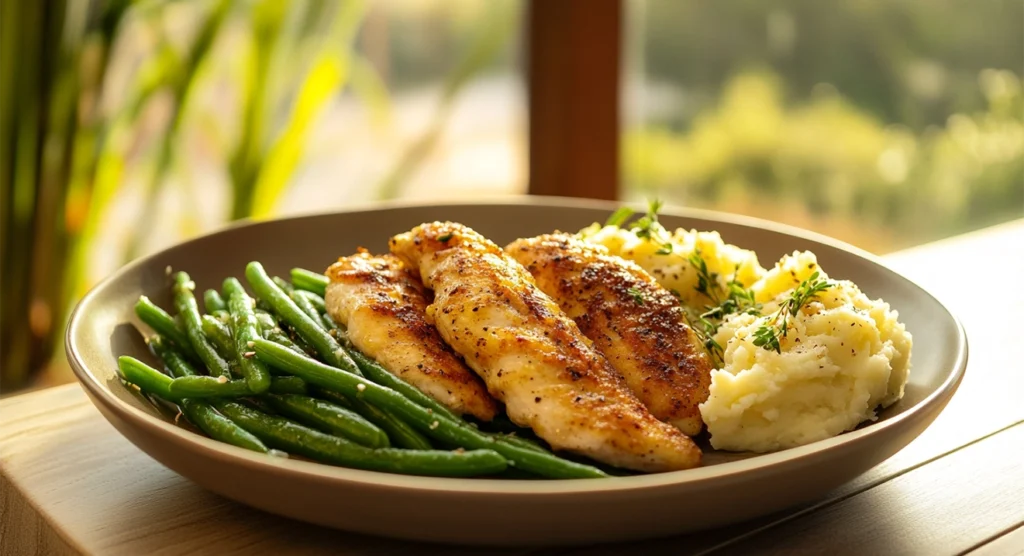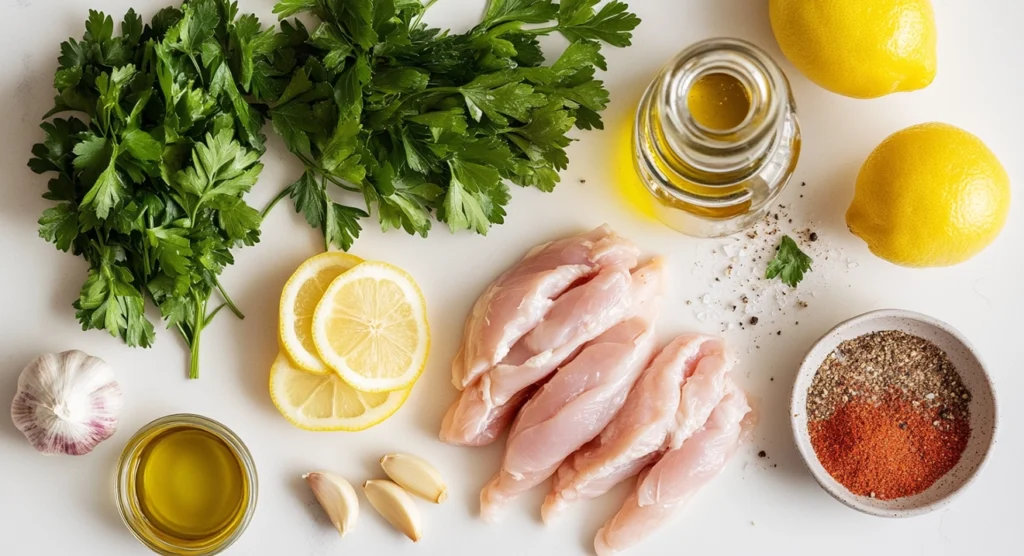
When Dinner Feels Like a Hug After a Long Day
Let’s be real. At the end of a exhausting, long day, the last thing you’d want to worry about is dinner. You’re tired, the kids are cranky, and the idea of chopping, dicing, and slow-roasting anything sounds like pure torture. But you still want something home-cooked. Something hearty. Something that tells your taste buds, “You made it through the day.”
That’s exactly why this chicken tenderloin recipe is your new go-to solution. It’s fast, full of flavor, and practically guarantees a clean plate from every family member. With just a handful of pantry staples and under 30 minutes, you can whip up juicy, flavorful chicken that hits all the right notes—comforting, savory, and soul-satisfying.
Table of Contents
Why Chicken Tenderloin Is a Weeknight Winner
What Are Chicken Tenderloin Recipe?
Chicken tenderloins are the small, strip-like muscles found beneath the chicken breast. Unlike full breasts, they’re naturally tender and cook quickly, making them a fantastic choice for busy weeknights. You don’t need to pound or slice them. Just season and cook.
Benefits for Busy Families
- Quick cooking: Done in 15–20 minutes flat
- Kid-approved: Mild flavor and soft texture
- Versatile: Works with nearly any side dish
- Budget-friendly: Often more affordable than chicken breasts
Nutritional Value of Chicken Tenderloins
| Nutrient | Per 100g (Cooked) |
|---|---|
| Calories | 130 |
| Protein | 26g |
| Fat | 3g |
| Carbohydrates | 0g |
| Iron | 0.9mg |
| Potassium | 256mg |
Chicken tenderloins are lean and protein-rich, making them ideal for low-carb or high-protein meal plans.
Ingredients for the Juiciest Chicken Tenderloin Recipe
To get the best out of your chicken, start with quality ingredients. Here’s what you’ll need:

Essential Ingredients Table
| Ingredient | Quantity | Notes |
| Chicken tenderloins | 1.5 lbs | Trimmed and patted dry |
| Olive oil | 2 tbsp | For marinating and searing |
| Garlic (minced) | 3 cloves | Fresh for full flavor |
| Lemon juice | 2 tbsp | Adds zing and tenderness |
| Smoked paprika | 1 tsp | For depth and subtle heat |
| Italian seasoning | 1 tsp | Herb blend for aroma |
| Salt | 1 tsp | Adjust to taste |
| Black pepper | 1/2 tsp | Freshly ground |
Feel free to tweak the seasoning to match your taste or use a store-bought seasoning blend if you’re short on time.
Step-by-Step Cooking Instructions
Getting dinner on the table shouldn’t feel like a chore. Here’s a foolproof method to make sure your chicken turns out perfect every time.
Quick & Easy Method for Busy Weeknights
- Marinate the Chicken
In a bowl, combine olive oil, lemon juice, garlic, smoked paprika, Italian seasoning, salt, and pepper. Toss in the chicken tenderloins, ensuring they’re fully coated. Let it sit for at least 15 minutes. - Sear to Lock in Flavor
Heat a nonstick skillet or cast-iron pan over medium-high heat. Add a drizzle of oil. Sear chicken for 3–4 minutes each side until golden and cooked through. - Check Doneness
Internal temperature should reach 165°F (75°C). Use a meat thermometer to be sure. - Rest and Serve
Let the chicken rest for 5 minutes to retain juices before slicing or serving whole.
Optional Additions:
- Deglaze the pan with a splash of chicken broth for a quick sauce.
- Garnish with chopped parsley or lemon zest.
- Add chili flakes for heat.
Serving Suggestions for a Complete Meal
Pairing your tenderloins with the right side dishes transforms it into a full-on dinner experience.
Best Sides to Serve With Chicken Tenderloin Recipe
- Garlic butter rice or herbed quinoa
- Roasted vegetables (zucchini, carrots, bell peppers)
- Steamed green beans with a touch of lemon
- Creamy mashed potatoes
- Crispy oven fries or sweet potato wedges
Meal Prep Tips
- Make a double batch and use leftovers in wraps or salads.
- Store in an airtight container in the fridge for up to 4 days.
- Freeze cooked tenderloins for up to 3 months.
- Reheat gently in a skillet or microwave with a splash of water to retain moisture.
Tips to Keep Chicken Tenderloins Juicy Every Time
Even the simplest recipes can go wrong without a few expert tips. Here’s how to avoid dry or overcooked chicken.
Secrets from the Kitchen:
- Don’t skip the marinade. Even 15 minutes makes a difference.
- Always use a hot pan to sear and lock in juices.
- Avoid overcrowding the skillet. Cook in batches if needed.
- Rest before slicing. This helps retain juices inside the meat.
- Use an instant-read thermometer to prevent overcooking.
Recipe Variations You’ll Love
Mix things up with these exciting twists:
Flavor Boosts:
- Honey Garlic Chicken Tenderloins: Add honey and soy sauce to the marinade.
- Cajun Spiced Tenderloins: Swap Italian seasoning for Cajun blend.
- Teriyaki Tenderloins: Use teriyaki sauce with sesame oil and ginger.
Cooking Methods:
- Oven-Baked: Preheat to 400°F. Bake on a lined sheet for 15–18 minutes.
- Air Fryer: Cook at 375°F for 12 minutes, flipping halfway.
- Grilled: Use an outdoor grill or grill pan. 3–4 minutes per side.
FAQs About Chicken Tenderloin Recipe
What’s the best way to cook chicken tenderloins quickly?
Searing in a skillet is the fastest way. With a hot pan, they cook in under 10 minutes and retain great flavor.
Can I bake chicken tenderloins instead of frying?
Absolutely. Just preheat the oven to 400°F and bake for 15–18 minutes. Line your tray with parchment for easy cleanup.
How do I know when chicken tenderloins are done?
Use a meat thermometer. Internal temperature should be 165°F (75°C). The juices should run clear.
Can I freeze cooked chicken tenderloins?
Yes. Let them cool, then freeze in a sealed bag or container for up to 3 months. Thaw overnight before reheating.
Can I use the same recipe for chicken breasts?
Yes, but cooking times will increase. Slice the breasts or pound them thin for faster results.
Conclusion – Quick, Juicy, and Unforgettable
There’s something incredibly satisfying about nailing a home-cooked meal without the stress. This chicken tenderloin recipe delivers on every level: it’s juicy, loaded with flavor, quick to make, and endlessly adaptable. Whether you’re cooking for your family or prepping ahead for the week, this dish will never let you down.
Ready to Cook?
Try this tonight and see the difference for yourself. And hey—if it becomes your new favorite weeknight dinner, snap a pic and tag us @QuickyCook. We’d love to see your creation!
